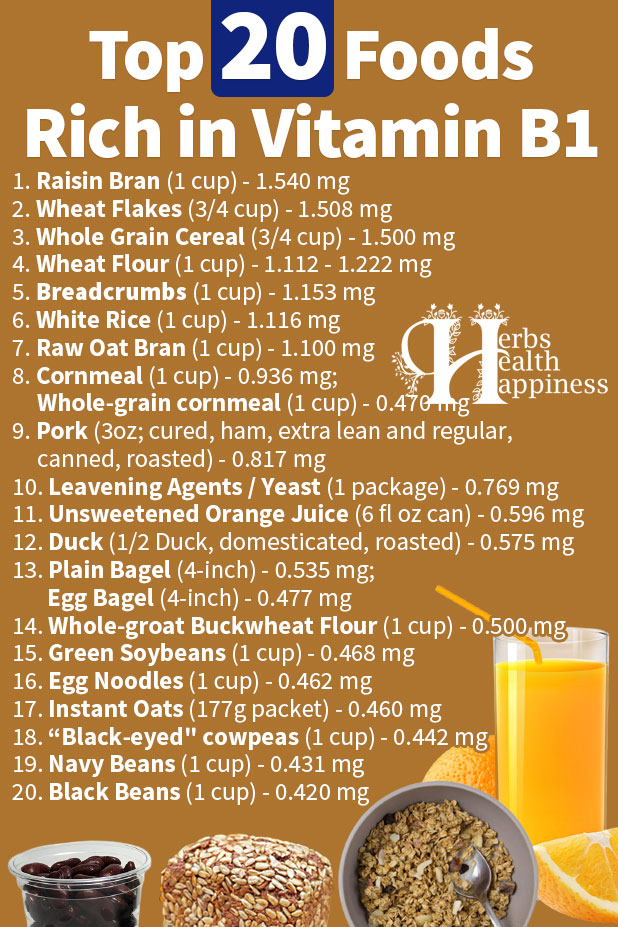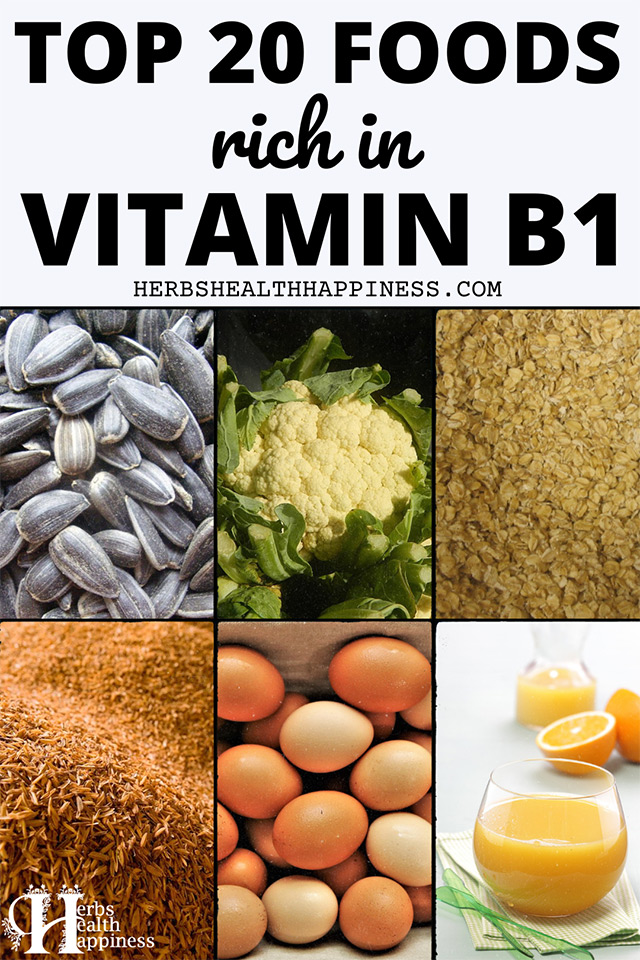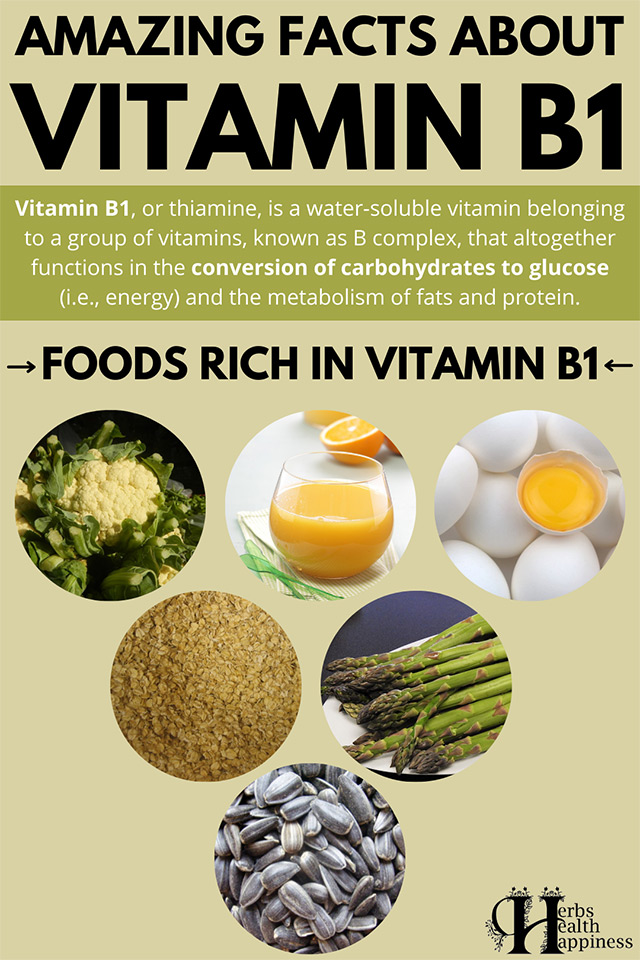
Top 20 Foods Rich In Vitamin B1
Graphic © herbshealthhappiness.com. Img sources Creative Commons – see foot of article
All About Vitamin B1 (Thiamine)
Vitamin B1, or thiamine, is a water-soluble vitamin belonging to a group of vitamins, known as B complex, that altogether functions in the conversion of carbohydrates to glucose (i.e., energy) and the metabolism of fats and protein. [1] Vitamin B1 is the first organic compound to be acknowledged as a vitamin and was only isolated and described in the 1930s. [2] Processes that depend on thiamine are vital in glucose metabolism, and numerous recent studies have linked thiamine in oxidative stress, protein processing, peroxisomal function, and gene expression. [3] In particular, vitamin B1 contributes to the metabolic reactions involved to form adenosine triphosphate (ATP), [1] the “molecular unit of currency” of intracellular energy transfer.
Vitamin B1 is required by the body to maintain a healthy central nervous system (CNS), keeping in check that the brain and the overall CNS are doing well in terms of their function. [1] In fact, vitamin B1 deficiency is associated with a wide array of neuropsychiatric symptoms distinct to anorexia nervosa. [4]In contrast, thiamine administration, as determined by Botez M. I., Botez T., Ross-Chouinard, and Lalonde (1993) in a 6-month clinical trial, enhances the neurophysiologic functions of epileptic patients on phenytoin medication, such as visuospatial analysis, visuomotor speed, and verbal abstracting ability. [5] Furthermore, Gibson and Blass (2007) reported that adding vitamin B1 to treatments for the glucose metabolism abnormality known to exist in Alzheimer’s disease (AD) patients potentiates the efficacy of these AD treatments. [3]
Vitamin B1 plays an indispensable role in the body’s process of catabolizing carbohydrates, and the intake of vitamin B1, either as part of one’s diet or through medical administration, has been demonstrated to prevent the formation of harmful by-products of glucose metabolism, reduce oxidativestress, and improve endothelial function – processes that are somewhat “defective” in diabetes patients. [6] Vitamin B1 therapy appears to promote the prevention of type 2 diabetes since it prevents dyslipidemia and the development of vascular complications related to clinical diabetes. [7]
Vitamin B1 is an “essential nutrient” in that humans and animals need to acquire it from their diet, unlike in bacteria, some protozoans, fungi, and plants wherein complex vitamin B1 biosynthesis occurs. [8]Fortunately, nature generously supplies humans with a delightful assortment of interesting vitamin B1-rich foods to choose from. Fish, particularly yellowfin tuna and pompano, boast a respectable amount ofvitamin B1 content and can fulfill around 35% or more of one’s daily requirement for vitamin B1 for every 200 calories worth of this food. [9] Tuna can offer 0.5 mg (33% daily value (DV)) per 100 gram serving, or 28% DV in a standard 3 oz serving, whereas pompano is rather better, providing 0.68 mg (45% DV) of thiamine in a 100 gram serving, or 0.6mg (40% DV) per fillet. [10] Brewer’s yeast too can be a rich source of vitamin B1, others even considering brewer’s yeast as the best vitamin B1 source because of its putative 4.3 mg/oz thiamine content. Wheat germ, brown rice, rice bran, oatmeal, legumes, peanuts, sunflower seeds, and dried soybeans are all packed with high content of vitamin B1. [11] A 100 g serving (approximately two cups) of sunflower seeds, for instance, as an onthe-go snack or saladgarnish can grant 1.48 mg of vitamin B1 in one’s diet. [10] Dietician David Grotto, as featured by Forbes writer Jenna Goudreau in her write-up, advises a diet with dry beans, including lentils, on it; dry beans, especially kidney beans, provide a healthy supply of not only vitamin B1 but also magnesium, molybdenum, soluble fiber, iron, and potassium – plus they come in a low number of calories (200 calories per cup)! [12]
The Recommended Daily Allowance for vitamin B1 for 0-6-month infants is 0.2 mg/day; 7-12-month infants, 0.3 mg/day; 1-3-year-old children, 0.5 mg/day; 4-8-year-old children, 0.6 mg/day; and 9-13-year-old children, 0.9 mg/day. The vitamin B1 requirement varies between males and females by the time one reaches adolescence and adulthood: 1.2 mg/day and 1.0 mg/day for male and female teenagers, respectively, and 1.2 mg/day and 1.1 mg/day for male and female adults, respectively. [13]Listed succinctly below are the top 20 foods (sorted by nutrient content) with significant amount of thiamine (in milligrams). Data is derived from the USDA National Nutrient Database for Standard Reference, Release 25:
Top 20 Foods Rich In Vitamin B1
1. 1 cup of ready-to-eat cereals (raisin bran) – 1.540 mg
2. 3/4 cup of ready-to-eat cereals (wheat flakes) – 1.508 mg
3. 3/4 cup of ready-to-eat cereals (whole grains) – 1.500 mg
4. 1 cup of cake wheat flour (white, enriched) – 1.222 mg; 1 cup of bread wheat flour (white, enriched) – 1.112 mg
5. 1 cup of bread crumbs (dry, grated, seasoned) – 1.153 mg
6. 1 cup of rice (white, long-grain, parboiled, enriched, dry) – 1.116 mg
7. 1 cup of raw oat bran – 1.100 mg
8. 1 cup of cornmeal (self-rising, degermed, enriched, yellow) – 0.936 mg; 1 cup of whole-grain cornmeal (yellow) – 0.470 mg
9. 3 oz of pork (cured, ham, extra lean and regular, canned, roasted) – 0.817 mg
10. 1 package of leavening agents (yeast, baker’s, active dry) – 0.769 mg
11. 6 fl oz can of orange juice (frozen concentrate, unsweetened, undiluted) – 0.596 mg
12. Duck (1/2 Duck, domesticated, cooked, roasted) – 0.575 mg
13. 4-inch bagel (plain, enriched, with calcium propionate [includes onion, poppy, and sesame]) – 0.535 mg; 4-inch egg bagel – 0.477 mg
14. 1 cup of whole-groat buckwheat flour – 0.500 mg
15. 1 cup of green soybeans (cooked, boiled, drained, without salt) – 0.468 mg
16. 1 cup of egg noodles (cooked, enriched) – 0.462 mg
17. 1 packet of cereal (oats, instant, fortified, plain, prepared with water (boiling water added or microwaved)) – 0.460 mg
18. 1 cup of “black-eyed” cowpeas (immature seeds, frozen, cooked, boiled, drained, without salt) -0.442 mg
19. 1 cup of navy beans (mature seeds, cooked, boiled, without salt) – 0.431 mg
20. 1 cup of black beans (mature seeds, cooked, boiled, without salt) – 0.420 mg [14]
Vitamin B1 – Summary
In summary, lean pork and other meats, wheat germ, liver and other organ meats, poultry, eggs, fish, beans and peas, nuts, and whole grains are the richest known dietary sources of vitamin B1; in comparison, dairy products, fruit, and vegetables are poor thiamine sources, [15] although they may supply vitamin B1 in small proportions and, in the case of dairy products, provide important nutrients that aid in vitamin B1 absorption. [11] Moreover, cooking or other forms of heat processing leads to significant thiamine losses (at least 25%). [15] Because of such, it is recommended that foods rich in vitamin B1 be consumed raw or in the form of salads, if possible. [11]

Top 20 Foods Rich In Vitamin B1
Graphic © herbshealthhappiness.com. Img sources Creative Commons – see foot of article

Top 20 Foods Rich In Vitamin B1
Graphic © herbshealthhappiness.com. Img sources Creative Commons – see foot of article
References:
[1] Vitamin B1 (thiamine). University of Maryland Medical Center. Retrieved 9 April 2013 from https://umm.edu/altmed/articles/vitamin-b1-000333.htm
[2] Rindi G. Thiamin. In Ziegler E. E. & Filer L. J. (Eds.). (1996). Present knowledge in nutrition (7th ed.). Washington D.C.: ILSI Press, 160-166.
[3] Gibson G. E. & Blass J. P. (2007). Thiamine-dependent processes and treatment strategies in neurodegeneration. Antioxidants & Redox Signaling, 9(10): 1605-1619. Retrieved 9 April 2013 from https://pubmed.ncbi.nlm.nih.gov/17685850
[4] Winston A. P., Jamieson C. P., Madira W., Gatward N. M., & Palmer R. L. (2000). Prevalence of thiamin deficiency in anorexia nervosa. International Journal of Eating Disorders, 28(4): 451-454. Retrieved 9 April 2013 from https://pubmed.ncbi.nlm.nih.gov/11054793
[5] Botez M. I., Botez T., Ross-Chouinard A., & Lalonde R. (1993). Thiamine and folate treatment of chronic epileptic patients: a controlled study with the Wechsler IQ scale. Epilepsy Research, 16(2): 157-163. Retrieved 9 April 2013 from https://pubmed.ncbi.nlm.nih.gov/8269914
[6] Page G. L., Laight D., & Cummings M. H. (2011). Thiamine deficiency in diabetes mellitus and the impact of thiamine replacement on glucose metabolism and vascular disease. International Journal of Clinical Practice, 65(6): 684-690. doi: 10.1111/j.1742-1241.2011.02680.x. Retrieved 9 April 2013 from https://pubmed.ncbi.nlm.nih.gov/21564442
[7] Thornalley P. J. (2005). The potential role of thiamine (vitamin B1) in diabetic complications. Current Diabetes Reviews, 1(3): 287-298. Retrieved 9 April 2013 from https://pubmed.ncbi.nlm.nih.gov/18220605
[8] Thiamine. Wikipedia. Retrieved 9 April 2013 from https://en.wikipedia.org/wiki/Thiamin
[9] 7 Foods rich in vitamin B1. Retrieved 9 April 2013 from https://fitday.com/fitnessarticles/nutrition/vitamins-minerals/7-foods-rich-in-vitamin-b1.html
[10] Top 10 foods highest in thiamin (vitamin B1). Retrieved 9 April 2013 from https://healthaliciousness.com/articles/thiamin-b1-foods.php
[11] What are the best sources of vitamin B1? Newsmax Media. Retrieved 9 April 2013 from https://newsmax.com/FastFeatures/sources-of-vitamin-B1/2011/03/16/id/389702
[12] Goudreau J. (2012). The 10 best foods you can eat. Forbes. Retrieved 9 April 2013 from https://forbes.com/sites/jennagoudreau/2012/05/04/the-10-best-foods-you-can-eat/
[13] Food and Nutrition Board, Institute of Medicine. (1998). Thiamin. Dietary reference intakes: Thiamin, riboflavin, niacin, vitamin B6, vitamin B12, pantothenic acid, biotin, and choline. Washington D.C.: National Academy Press, 58-86.
[14] Thiamin (mg) content of selected foods per common measure. USDA National Nutrient Database for Standard Reference, Release 25. Retrieved 5 April 2013 from https://ars.usda.gov/SP2UserFiles/Place/12354500/Data/SR25/nutrlist/sr25w404.pdf
[15] Lonsdale D. (2006). A review of the biochemistry, metabolism and clinical benefits of thiamin(e) andits derivatives. Evidence-Based Complementary and Alternative Medicine, 3(1): 49-59. Retrieved 9 April 2013 from https://ncbi.nlm.nih.gov/pmc/articles/PMC1375232/
Infographic image sources:
https://www.publicdomainpictures.net/pictures/300000/velka/brown-eggs-in-a-basket-top-view.jpg
https://commons.wikimedia.org/wiki/File:Fresh_asparagus.jpg
https://commons.wikimedia.org/wiki/File:Rice_husk.jpg
https://en.wikipedia.org/wiki/File:Breading.jpg
https://commons.wikimedia.org/wiki/File:Raw_pork_spareribs.jpg
https://commons.wikimedia.org/wiki/File:Orangensaft_1.JPG
https://commons.wikimedia.org/wiki/File:4336Cuisine_and_foods_of_Baliuag,_Bulacan_21.jpg
https://commons.wikimedia.org/wiki/File:Sunflowers_seeds.jpg
https://commons.wikimedia.org/wiki/File:Porridge_oats.JPG
★ Get My Books - 100% FREE:
😳 Tinnitus And Brain Health?
After 47 years of studies and countless brain scans done on more than 2,400 tinnitus patients, scientists at the MIT Institute found that in a shocking 96% of cases, tinnitus was actually shrinking their brain cells.
As it turns out, tinnitus and brain health are strongly linked.
Even more interesting: The reason why top army officials are not deaf after decades of hearing machine guns, bombs going off and helicopter noises…
Is because they are using something called "the wire method", a simple protocol inspired by a classified surgery on deaf people from the 1950s...
★ How To Get Rid Of Nail Fungus:
★ Does Your Salad Contain This Vegetable?
★ 20 Natural Painkillers In Your Kitchen (Video):
★ Men's Prostate Health:

2. Famous Chef Sheds 60lbs Researching New Paleo Recipes: Get The Cookbook FREE Here
3. #1 muscle that eliminates joint and back pain, anxiety and looking fat
4. 7 odd foods that KILL your abdominal fat (surprising fat-fighters)
5. The TRUTH about bread (Will surprise you!)
6. [PROOF] Reverse Diabetes with a "Pancreas Jumpstart"
7. Here's What Happens When You "Unlock Your Hip Flexors"
8. The #1 WORST food that CAUSES Faster Aging (beware -- Are you eating this?)
The #1 Muscle That Eliminates Joint And Back Pain, Anxiety And Looking Fat
By Mike Westerdal CPT
Can you guess which muscle in your body is the #1 muscle that eliminates joint and back pain, anxiety and looking fat?
This is especially important if you spend a significant amount of time sitting every day (I do, and this really affects me in a big way!)
Working this "hidden survival muscle" that most people are simply not training because no-one ever taught them how will boost your body shape, energy levels, immune system, sexual function, strength and athletic performance when unlocked.
If this "hidden" most powerful primal muscle is healthy, we are healthy.
Is it...
a) Abs
b) Chest
c) Glutes
d) Hip Flexors
Take the quiz above and see if you got the correct answer!
P.S. Make sure you check out this page to get to know the 10 simple moves that will bring vitality back into your life:
If you enjoyed this page:














